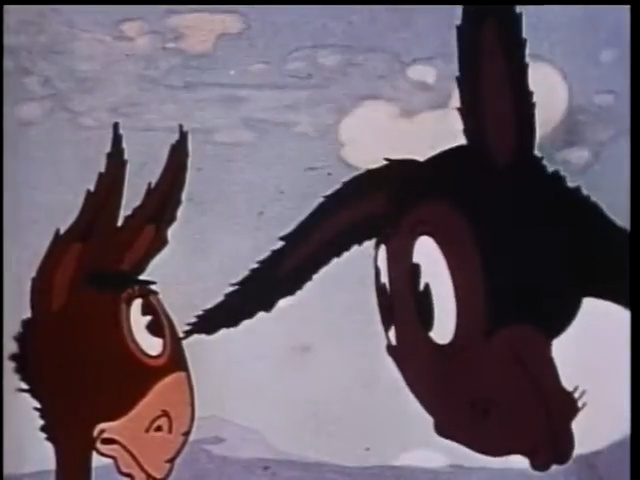|
Hunky And Spunky
''Hunky and Spunky'' were fictional characters, appearing in the series of animated short subjects produced by Fleischer Studios for Paramount Pictures from 1938 to 1941. Filmed in Technicolor (three-strip), the series revolves around a mother burro and her son. History Hunky is a mother burro and Spunky is her young son. The initial film, titled ''Hunky and Spunky'', takes place in the Old West, where a prospector attempts to make Spunky into his pack animal. ''Hunky and Spunky'' was nominated for the 1938 Academy Award for Best Short Subject (Cartoons). A positive contemporary review of ''Hunky and Spunky'' in ''Film Daily'' praised the short for introducing "funny new characters", and stated that the short's device of having the animals speak in "donkey talk" "will amuse the kids".(July 1, 1938). Review of ''Hunky and Spunky''. ''Film Daily'', Vol. 74, No. 1, p. 4 Fleischer Studios went on to produce six more cartoons featuring Hunky and Spunky: ''Always Kickin''' (1939), ''Th ... [...More Info...] [...Related Items...] OR: [Wikipedia] [Google] [Baidu] |
Famous Studios
Famous Studios (renamed Paramount Cartoon Studios in 1956) was the first animation division of the film studio Paramount Pictures from 1942 to 1967. Famous was founded as a successor company to Fleischer Studios, after Paramount seized control of the aforementioned studio after the departure of its founders, Max and Dave Fleischer, in 1942.Maltin, Leonard (1980, rev. 1987). ''Of Mice and Magic''. New York: Plume. Pg. 311 The studio's productions included three series started by the Fleischers—''Popeye the Sailor'', ''Superman'', and ''Screen Songs''—as well as '' Little Audrey'', ''Little Lulu'', ''Casper the Friendly Ghost'', ''Honey Halfwitch'', '' Herman and Katnip'', '' Baby Huey'', and the anthology '' Noveltoons'' series. The ''Famous'' name was previously used by Famous Players Film Company, one of several companies which in 1912 became Famous Players-Lasky Corporation, the company which founded Paramount Pictures. Paramount's music publishing branch, which held th ... [...More Info...] [...Related Items...] OR: [Wikipedia] [Google] [Baidu] |
Animated Duos
Animation is a method by which still figures are manipulated to appear as moving images. In traditional animation, images are drawn or painted by hand on transparent celluloid sheets to be photographed and exhibited on film. Today, most animations are made with computer-generated imagery (CGI). Computer animation can be very detailed 3D animation, while 2D computer animation (which may have the look of traditional animation) can be used for stylistic reasons, low bandwidth, or faster real-time renderings. Other common animation methods apply a stop motion technique to two- and three-dimensional objects like paper cutouts, puppets, or clay figures. A cartoon is an animated film, usually a short film, featuring an exaggerated visual style. The style takes inspiration from comic strips, often featuring anthropomorphic animals, superheroes, or the adventures of human protagonists. Especially with animals that form a natural predator/prey relationship (e.g. cats and mice, coyo ... [...More Info...] [...Related Items...] OR: [Wikipedia] [Google] [Baidu] |
Fictional Donkeys
Fiction is any creative work, chiefly any narrative work, portraying individuals, events, or places that are imaginary, or in ways that are imaginary. Fictional portrayals are thus inconsistent with history, fact, or plausibility. In a traditional narrow sense, "fiction" refers to written narratives in prose often referring specifically to novels, novellas, and short stories. More broadly, however, fiction encompasses imaginary narratives expressed in any medium, including not just writings but also live theatrical performances, films, television programs, radio dramas, comics, role-playing games, and video games. Definition Typically, the fictionality of a work is publicly marketed and so the audience expects the work to deviate in some ways from the real world rather than presenting, for instance, only factually accurate portrayals or characters who are actual people. Because fiction is generally understood to not fully adhere to the real world, the themes and context ... [...More Info...] [...Related Items...] OR: [Wikipedia] [Google] [Baidu] |
Television Series By U
Television, sometimes shortened to TV, is a telecommunication medium for transmitting moving images and sound. The term can refer to a television set, or the medium of television transmission. Television is a mass medium for advertising, entertainment, news, and sports. Television became available in crude experimental forms in the late 1920s, but only after several years of further development was the new technology marketed to consumers. After World War II, an improved form of black-and-white television broadcasting became popular in the United Kingdom and the United States, and television sets became commonplace in homes, businesses, and institutions. During the 1950s, television was the primary medium for influencing public opinion.Diggs-Brown, Barbara (2011''Strategic Public Relations: Audience Focused Practice''p. 48 In the mid-1960s, color broadcasting was introduced in the U.S. and most other developed countries. The availability of various types of archival storag ... [...More Info...] [...Related Items...] OR: [Wikipedia] [Google] [Baidu] |



